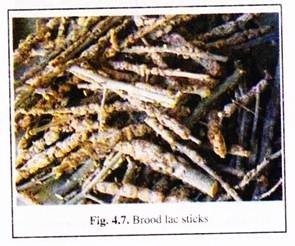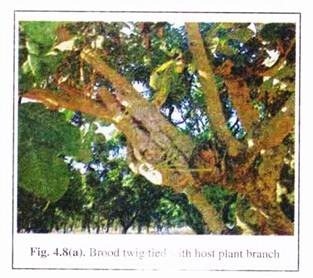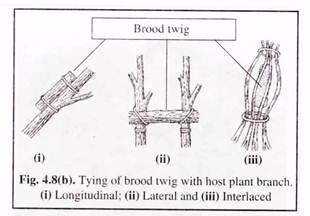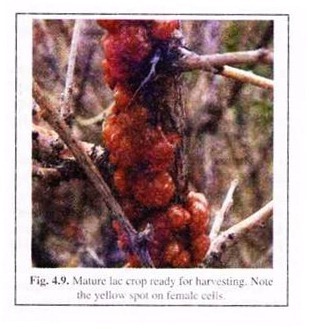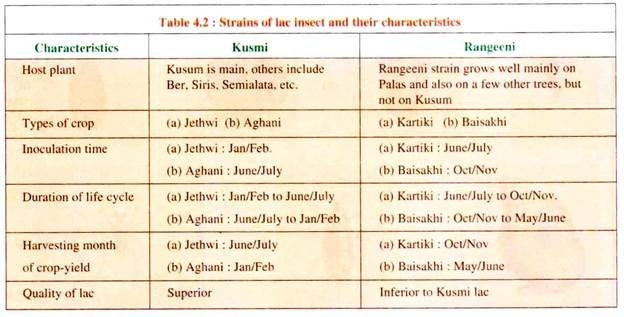The following points highlight the four main stages involved in lac cultivation. The stages are: 1. Inoculation 2. Swarming 3. Phunki Removal 4. Harvesting of Lac.
Lac Cultivation: Stage # 1. Inoculation:
Inoculation is the first stage of lac cultivation. It is the process by which newly hatched (brood) nymphs get associated with new branches of host plants.
It may occur by two ways:
(a) Natural/Self-/Auto- inoculation and
ADVERTISEMENTS:
(b) Artificial inoculation.
(A) Natural/Self-/Auto- Inoculation:
It occurs naturally and routinely. In this process of inoculation, the swarmed nymphs of one plant infect the same host again and start to inhabit (encrust) on it. However, such inoculation process is discouraged for certain reasons.
Drawbacks of Natural Inoculation:
ADVERTISEMENTS:
(i) Nutrition Deficiency:
If successive inoculations take place in the same host plant, it results in stunted growth of the infested plant. Consequently, the insects may not get sufficient nutrition from the host plant. This in turn, will adversely affect the insect’s growth and lac secretion.
(ii) Non-Uniform Inoculation:
In natural system, inoculation may not take place in uniform sequence. In such case one/two crops may be absent, resulting in decreased lac production.
ADVERTISEMENTS:
(iii) Adverse Climate:
The swarming of nymph depends on several climatic factors like rainfall, intensity of sunlight, direction of wind, humidity, etc. These factors, if not favourable, may affect the inoculation of nymphs and growth of the host plant at the same time.
(iv) Parasites and Predators:
If the lac is not harvested in time, the insects may invite their predators and parasites to multiply in large numbers on them. Thus, the ultimate growth of the insect, as well as lac production may be hampered.
(B) Artificial Inoculation:
Due to several problems in natural system of inoculation, as mentioned above, nowadays artificial inoculation is being practised. It is brought about by the agency of man. The main idea behind this system of inoculation is to overcome the drawbacks of natural system.
After the brood lac has been cut from the plants, it is necessary to subject it to proper examination, so that only healthy lac with minimum signs of predator and parasite damage is selected for use as brood lac. This is necessary to minimize the chances of propagation of the lac insect enemies.
Artificial inoculation involves the following steps:
(1) Transfer/Inoculation of Seed Twig/Brood Twig:
ADVERTISEMENTS:
The encrustation on a branch of host plant, if on squeezing is seen to exude red liquid, then this part of the branch can be considered as seed twig/ brood twig/brood stick. It indicates that living eggs are present within the encrustation that can be used for inoculation as seed.
In artificial inoculation, such seed twigs are cut in length of 20-30 m (Fig. 4.7). Then these cut pieces are tied to fresh succulent twigs of the host plant in such a way that each brood twig gets touched at several places through which migration of nymphs from brood twig to host twig can take place (Fig. 4.8a).
Brood twigs can be tied to host plant branch by three ways:
(i) Longitudinal fashion where brood twig is tied longitudinally with host branch,
(ii) Lateral fashion where brood twig is placed in between 2 host branches and tied with them, and
(iii) Interlaced fashion where singled brood twig is tied with several host branches together (Fig. 4.8b).
Precautions to be taken during Artificial Inoculation:
(a) Fully mature and healthy brood twigs, free from pest infestation and disease should be taken.
(b) Brood twig or seed twig meant for inoculation should be used immediately after crop cutting and should not be kept for a long time.
(c) To prevent falling of seed twig, tying of seed twig should be done securely on the upper surface of branches. It will ensure full contact for quick and easy crawling of nymphs from seed twigs to host twigs.
(d) Generally, for better inoculation, 3-4 seed twigs should be tied at one place of host twig.
(e) If the brood twig is taken from a particular host plant year after year, it may deteriorate the quality of lac production. Therefore, alteration of both brood and host is preferred for better quality of lac and proper nutrition of the nymphs.
(f) Humid weather may prevent swarming of nymph from brood. Hence, room-stored seed lac twigs may be heated to 200°C to induce swarming prior to tying.
(g) Cultivation of Kusmi in place of Rangeeni and vice versa should be avoided.
Time of Inoculation:
Each strain of lac insect (Rangeeni and Kusmi) yields two crops a year: Kartiki and Baisakhi in case of Rangeeni, and Jethai and Aghani in case of Kusmi. So the inoculation time of different strains is different. For Kartiki June/July; for Baisakhi October/November; for Aghani July and for Jethai is January/February.
Lac Cultivation: Stage # 2. Swarming:
It is most important stage of lac cultivation. Following tying, the nymphs swarm from brood and migrate to tender and succulent twigs of host plant to infest them (Fig. 4.5b). The time of swarming can be noted by the colour change of the eggs.
At the time of hatching, the eggs become orange coloured. Following swarming of nymphs, the hollow cavities left in the cell get covered with- wax. Thus it is an indication that swarming has taken place.
Lac Cultivation: Stage # 3. Phunki Removal:
The operation pertains to the removal of brood lac twigs used for inoculation purposes, and the used up brood lac after complete emergence of lac nymphs from female cells is called phunki removal. Ordinarily, the emergence of lac nymphs from the brood lac ceases after three weeks.
The phunki lac is then scrapped off from the brood lac to avoid emergence of enemy insects. Phunki bundles are pulled down from the host trees with the help of pole mounted phunki hook or by climbing on trees.
Lac Cultivation: Stage # 4. Harvesting of Lac:
Harvesting is the process of collection of lac from the host trees. It is done by cutting the lac encrusted twigs when it is matured.
Harvesting can be done in two ways:
(i) Immature Harvesting:
In this case lac is collected before swarming. Lac, thus obtained, is called ‘ARILAC’. The lac insect may be damaged at the time of immature harvesting which would cause population destruction of lac insects and may result in great economic loss to cultivators. However, in case of Palas lac (Rangeeni lac), this type of lac was found to give better quality of production. So immature harvesting is encouraged only for this lac.
(ii) Mature Harvesting:
In this case, lac is collected after swarming. The lac, thus obtained is called ‘Mature Lac’. For mature lac harvesting, it is very important to know the exact date of emergence and swarming of nymphs. A simple visual method is adopted for this purpose. A yellow spot develops on the posterior side of the female lac cell toward crop maturity.
Gradually the spots spread forward until it covers half of the cell. Cutting of twigs for harvesting can be done at any time between the stages while the yellow spot occupies one-third to one-half of the cell area (Fig. 4.9). Sometimes, it is desirable to wait till the emergence of first new nymphs.
(iii) Harvesting Time:
In accordance with different inoculation time, harvesting time for different crops are also different. The Kartiki crop is harvested in October/November: Baisakhi in May/June; Aghani in January /February and Jethwi in June/July (Table 4.2).
Some special measures to be taken during harvesting:
Following considerations are recommended for harvesting:
(1) Only mature crops should be harvested. Immature/arilac cutting should be avoided except in Palas lac.
(2) A moderate crop is said to be the one from which nymph will emerge in 7-10 days. So the crop should be harvested within the above said days prior to nymphal emergence.
(3) If self-inoculation is not required, then the entire crop may be reaped. In case of Rangeeni crop, only the lac encrusted twigs are cut, while in case of Kusum crop, reaping should be accompanied with pruning.
(4) The brood sticks harvested, should be utilised for inoculation as soon as possible. If needed, storage should be done in shaded, well ventilated room.
(5) Harvesting of lac crop at maturity can prevent the crisis of brood lac to a large extent without affecting the quality of lac (obtained as stick lac).
